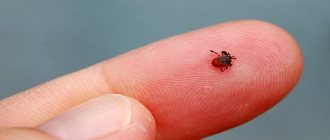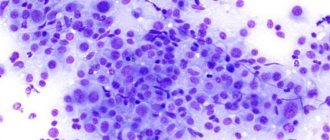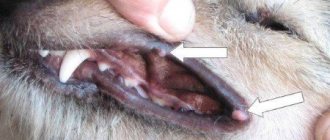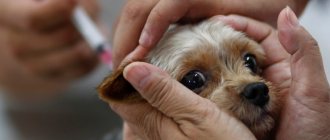5 / 5 ( 1 voice )
Infectious diseases are terrible not only for animals, but also for humans. Leptospirosis in dogs is one of the most dangerous diseases (more than half of infections are fatal). Every pet owner should know the symptoms and preventive measures of leptospirosis so that the infection does not become fatal for the pet.
Description of the disease
Leptospirosis or infectious jaundice, or Weil's disease, is an infectious disease caused by the bacterium Leptospira. Distributed almost throughout the world (except Antarctica), affecting most species of mammals. More than 200 species and subspecies of the pathogenic bacterium Leptospira (called serotypes or serogroups) are known to veterinary medicine. But more than 50% of them do not cause pathologies.
Important! Leptospira bacteria are close “relatives” of borreliosis and syphilis.
The infection is resistant to low temperatures and can remain viable and virulent for many months. Even if the ambient temperature drops to -70 degrees. An increase in ambient temperature combined with an increased level of humidity is a favorable environment for maintaining life activity for up to a year and a half. Most often found in stagnant bodies of water, with a large accumulation of Leptospira bacteria, a visible film can form on the surface of the water.
In water it can remain active for 30 days, under favorable conditions. In running water no more than 10 days. In soil with high humidity, Leptospires remain virulent for up to 300 days.
Bacteria are susceptible to drying out and changes in pH. When the temperature rises to 76 degrees and above, the infection dies instantly.
Routes of infection
The main routes of infection with leptospirosis:
- Contact. Infection occurs through contact of mucous membranes or damaged skin with contaminated soil, water, sick animals or their secretions.
- Nutritional. Infection occurs by the bacteria entering the stomach - quenching thirst from infected bodies of water, eating raw meat of leptospirosis carriers or contaminated (infected animals) products.
Important! Dogs can shed Leptospira in their urine without showing clinical signs.
Carriers of leptospirosis are most often rodents and small predators that eat them:
- Rats;
- Hedgehogs;
- Shrews;
- The bats;
- Voles;
- Nutria;
- Ferrets;
- Martens;
- Arctic foxes;
- Foxes.
This is not the entire list of potential carriers of leptospirosis. Almost all mammals are susceptible to the disease, including cattle, artiodactyls, and almost all canines. Remarkably, cats are the least likely to get sick.
How do animals become infected?
The development of the disease in dogs is caused by the bacterium Leptospira interrogan. In swampy and damp soil, stagnant bodies of water, leptospira can remain in a viable state for a long time, although they die at high temperatures, treatment with disinfectants, and exposure to UV radiation.
This means that most often pathogenic microorganisms penetrate through contact, through contact with infected elements: water, soil, other animals. The dog may get injured or pathogenic flora may get on the mucous membranes. But besides this, there is also a nutritional route of infection, for example, if a dog drank water from an infected pond or ate raw meat from carriers of leptospirosis.
Remember that rodents and insectivores are the main reservoir of pathogens in nature.
In general, it is noted that it is water that poses a particular danger to dogs. Under suitable conditions, Leptospira retains its viability up to 30 in stagnant bodies of water, and in running water it lives no more than ten days. Therefore, carefully ensure that the dog does not lap from puddles, ponds, lakes, etc.
In soil with high humidity, bacteria have a viability of up to three hundred days. And besides this, other animals can become a source of infection. For example, dogs often carry Leptospira and excrete it in their urine without showing clinical signs. Please note that leptospirosis carriage continues in dogs - up to 17 months
Symptoms and signs in dogs
The disease has a huge number of clinical signs, as it affects almost all internal organs, nervous and circulatory systems, and skeletal muscles . American doctors have nicknamed leptospirosis the chameleon disease, because due to the number of symptoms, leptospirosis can be confused with canine distemper or infectious hepatitis.
Main symptoms and signs of leptospirosis:
- Apathetic state, inactivity;
- Refusal to eat;
- Redness or yellowing of mucous membranes;
- Vomit;
- Diarrhea, other signs of gastrointestinal disorders;
- Blood in the urine, dark urine;
- Poor urination, decreased amount of urine;
- Stomatitis;
- Increased body temperature;
- Deterioration of blood clotting;
- Lameness, loss of coordination;
- Shortness of breath, rapid pulse;
- Wheezing when breathing;
- Yellowness of the epithelium and mucous membranes;
- Dehydration;
- Abdominal pain;
- Anorexia.
Most often, symptoms appear 4–9 days after infection. Signs of leptospirosis may vary depending on which organs are affected. All organs may be affected, in which case the symptoms will be extensive. But the greatest danger this disease poses is that the symptoms are not always pronounced; it all depends on the individual characteristics of the body.
After entering the body, the easiest way for Leptospira bacteria to penetrate is the kidneys; therefore, the first clinical signs are associated with urination. Then the functioning of the liver, gastrointestinal tract, and spleen is disrupted. Also, the walls of blood vessels are destroyed, the functioning of the circulatory system is disrupted, which leads to internal bleeding.
Important! Animals that have recovered from the disease remain carriers of Leptospira for a long time.
Leptospirosis in dogs - symptoms of the disease
The causative agent of leptospirosis enters the body through the oral cavity, mucous membranes, and skin. It quickly spreads to various organs and systems. These are the liver, kidneys, central nervous system. Then the pathogen multiplies and appears in the blood in significant quantities. This is called leptospiremia. As a result, vasculitis, endothelial damage, bleeding, hypovolemia, and hemolysis develop.
Clinical signs of leptospirosis include lethargy, anorexia, vomiting, and fever. Abdominal tenderness, lower back pain, and myalgia/arthralgia are also observed. Possible polyuria/polydipsia, shortness of breath, cough, diarrhea. Enlarged kidneys, jaundice, petechiae, and dehydration may also occur.
Lethargy, lack of appetite, and vomiting are associated with kidney damage. There may also be an increase in thirst and urine output, but less frequently. In severe cases, there is necrosis of the tip of the tongue associated with uremia. Pain may develop due to arthralgia, myalgia, acute nephritis, intussusception and uveitis. Necrosis of the tip of the tongue due to uremia can be a painful condition that is relieved by lavage with dilute chlorhexidine or the use of lidocaine or systemic analgesics.
Forms of leptospirosis
Leptospirosis in dogs is divided into 3 forms - chronic, hemorrhagic and icteric. The symptoms depend on the form of the disease. The state of the dog’s immune system determines the nature of the disease.
Chronic
The disease enters the chronic phase if the dog has managed to get sick from other types of leptospirosis. The chronic form lasts several years, and with a decrease in immunity or concomitant diseases it reappears. Diagnosed quite rarely.
Symptoms of chronic leptospirosis:
- Anorexia, loss of weight and appetite;
- Pallor of mucous membranes;
- Enlarged lymph nodes;
- Epithelial necrosis;
- Hard breath;
- Apathetic state;
- Cardiopalmus;
- Lack of estrus in females and sexual desire in males;
- Stillbirth (loss of fetuses in females).
Hemorrhagic
The anicteric phase of leptospirosis occurs most often in fully formed individuals. The duration of the acute hemorrhagic phase is up to 7 days . If treatment is untimely or incorrect, death occurs in 70% of cases, or the disease progresses to the chronic stage.
The Leptospira bacterium in the hemorrhagic form of the disease primarily affects the circulatory system. Based on this, the clinical signs are:
- A sharp increase in body temperature to 41 degrees or more;
- Increased thirst;
- “Marbled” mucous membranes (bright red pigment of the mucous membranes interspersed with pale pink and white);
- Refusal to eat;
- Lethargy, inactivity;
- Diarrhea;
- Vomit;
- Dehydration;
- Cramps.
After 3–4 days, the body temperature drops to normal or lower. Blood impurities are clearly visible in the vomit and stool. Within 2–3 days, with a probability of more than 80%, the dog can no longer be saved. The animal will die from dehydration or internal bleeding.
Jaundice
A form of leptospirosis, called icteric, is diagnosed more often in dogs with immature immunity, under the age of two years. The acute course of the icteric phase lasts up to 7 days , the mortality rate is about 65%.
The symptoms are similar to hemorrhagic . The main difference between the two phases is the pigmentation of the mucous membranes; during the icteric phase, the mucous membranes of the mouth, eyes and the upper layer of the epithelium become yellow. This is due to the fact that the Leptospira bacterium is localized in the liver. Leads to increased levels of bilirubin in the blood, which in turn gives a yellow tint.
Death occurs from intoxication of the body.
Leptospirosis in animals
Methods of infection with leptospirosis in dogs:
- Contact – infection occurs through direct contact with an infected animal, or by immersion in bodies of water where this infection exists.
Nutritional – when eating the corpses of other animals, or when eating contaminated food.- Transmissible - as a result of insect bites.
If the dog is walked without a leash and is not prevented from entering open water bodies, the risk of contracting leptospirosis increases several times. Most often, the infection is transmitted from rats, so meeting these animals can be a problem for dog owners.
Important! The incubation period for leptospirosis is 2-10 days. But already when the first signs of infection appear, you should contact a veterinarian, especially if prior contact with rats has been registered or the dog was in an unknown body of water. Timely laboratory tests allow treatment to begin early, resulting in increased effectiveness.
Classification of leptospirosis
With this disease, damage primarily occurs to the kidneys, liver and lungs. The following forms of leptospirosis are distinguished:
- Jaundice form: the liver is mainly affected. The main symptom is yellowness of the surface of the skin and the whites of the eyes.
- Hemorrhagic form: yellowing of the skin may not be observed, although the target organs are the liver, kidneys, and lungs.
Based on severity, leptospirosis is divided into:
- Acute phase. All symptoms are pronounced, appear sharply, with a high degree of intensity. May be fatal.
- Subacute phase.
- Chronic phase.
- Latent (asymptomatic) phase.
Symptoms of leptospirosis in dogs
All forms of the disease have the same clinical picture, but what distinguishes them is the intensity of its course. The main symptoms include:
- Temperature rises to 40 degrees.
- Refusal of food.
- Thirst. The dog drinks a lot.
- Lethargy.
- Yellowness of the whites of the eyes and skin.
- Hyperemia of the whites of the eyes in the hemorrhagic form.
- Ulceration of the skin.
- Hemorrhages and bleeding in the hemorrhagic form.
- Obvious pain on palpation of the abdominal cavity.
The listed symptoms indicate the severity of the animal’s condition, so it needs intensive therapy. With all forms of leptospirosis, symptoms can be mild, so if the animal has been in contact with a potential source of infection, it must also be shown to a doctor to rule out the disease, or timely therapy should be started when it is diagnosed.
Important! The disease is dangerous not only for animals, but also for humans, as it is transmitted from pets.
If there is reason to suspect an animal is infected with leptospirosis, it is better to contact the laboratory and conduct a special study. It is much more effective to prevent the severity of the disease than to treat a pet with pronounced symptoms.
Diagnostic methods
The main carrier of Leptospira is blood, or rather the antibodies produced by the body against the bacterium. Antibodies can be detected as early as 10 days after infection. Leptospira can then be detected in urine. Therefore, blood and urine collection are an exceptional condition for the correct diagnosis of leptospirosis.
Important! Blood and urine tests provide a more plausible picture before introducing antibiotics into a dog's body, regardless of the duration of symptoms.
Test for leptospirosis in dogs
The microagglutination test, a serological blood test, is the most widely used diagnostic test for leptospirosis. But it must be carried out in conjunction with urine tests, and the procedure must be repeated after 2–3 days . Since in the initial stages the number of antibodies to Leptospira may be “within normal limits” (1:100 and even 1:200 is considered normal in regions that do not have outbreaks of epidemics). Also, the results are highly dependent on the quality control of the laboratory.
Sources of infection.
The disease is more often recorded in autumn and summer. Infection occurs through the nutritional route, through the digestive tract. Dogs get sick by eating infected meat, most often rodents.
Also drinking water from puddles or polluted water bodies. Moreover, the bacterium can enter the body through the mucous membranes of the mouth, eyes and nose while swimming and hunting game.
Several more ways of infection
:
- flea, tick and mosquito bites;
- when communicating with infected animals;
- through care and feeding items;
- during mating.
Dogs with reduced immunity are more likely to get sick. If they are kept in a group, in an unfavorable environment, the possibility of getting sick also increases.
The incubation period lasts 3-11 days, when there are no symptoms yet. The bacteria then enter the bloodstream and spread to all organs. They secrete toxins and poisons that destroy the walls of blood vessels. Intoxication of the body begins. Poisons damage the central nervous system and provoke seizures.
5-8 days after infection, the dog begins to release the pathogen into the environment. This can last from several months to 2-3 years.
Symptoms.
Leptospirosis occurs with or without clinical symptoms. The latter is the most dangerous for others. Signs of the disease may be completely absent or manifest in the form of kidney or liver failure. For every 1,000 infected dogs, 100 show clinical symptoms. Carriers of the pathogen can only be identified by testing urine and blood in the laboratory.
In the acute form it is difficult. Develops quickly. The kidneys are the first to be affected, leading to vomiting and urinary retention. Next are the genitourinary system, liver, brain neurons, eyes and lungs. Symptoms of leptospirosis in dogs appear depending on which organ is more affected.
There are two forms of leptospirosis - hemorrhagic and icteric.
Hemorrhagic form of leptospirosis.
The hemorrhagic form occurs without jaundice. It is more often observed in adult dogs in the acute and subacute periods. Symptoms appear on days 2-3, the duration of the disease is from 5 to 25 days. Half of the sick animals die; in the rest, the disease becomes chronic. Manifested by weakness, refusal to feed, paralysis of limbs or convulsions, increased thirst.
Signs of leptospirosis in dogs may appear on the first day. This is a sharp increase in temperature to 41.5 degrees, lethargy. The dog drinks often and reacts poorly to his name. Pallor of the mucous membranes appears. On days 2-3, a distinctive symptom of the hemorrhagic form appears - bleeding of the gums and mucous membranes, the temperature drops by a couple of degrees. As the bacterium destroys the walls of blood vessels, characteristic bleeding appears in the internal organs.
There is severe diarrhea and vomiting mixed with blood. Diarrhea gives way to constipation, stool contains mucus and blood clots. At the injection sites there are characteristic hematomas due to vascular weakness. When palpating the area of the kidneys and liver, severe pain is felt. The dog is lethargic and lies around a lot. When neurons in the brain are damaged, brain dysfunction, convulsions and paralysis appear.
Jaundice form of leptospirosis.
The main symptom of this form of leptospirosis is yellowing of the mucous membranes of the mouth, eyes, genitals, inner surfaces of the ears, and skin.
The dog refuses food, often lies down and loses a lot of weight. Diarrhea, vomiting, and dehydration appear. Kidney and liver failure and digestive tract disorders are also noted. Pain on palpation of the kidney and liver area.
Death occurs from toxic shock due to strong exposure to bacterial poisons and from dehydration.
Pregnant dogs do not carry puppies to term, or they are stillborn. Postpartum complications often occur. Estrus may be delayed. In male dogs, inflammation of the urethra and preputial sac is noted. Sick animals may urinate at home.
Treatment
Treating leptospirosis at home, self-diagnosis and self-medication is prohibited! Treatment is prescribed only by a qualified veterinarian and only after laboratory tests. In this case, the likelihood of positive dynamics during therapy increases.
Treatment requires comprehensive treatment, aimed primarily at destroying the Leptospira bacterium itself. It is also necessary to restore the body, remove intoxication and normalize the functioning of the affected internal organs.
In addition to drug treatment, the dog must be prescribed a diet. Food should only be of high quality, low in fat and protein. Drinking plenty of fluids and eating small meals is prescribed.
List of drugs
| Intramuscularly | ||
| Name | Price | Application |
| Hyperimmune serum against leptospirosis | 424 rubles | 0.5 ml per 1 kg of body weight; 1 time per day 2 – 3 days |
| Streptomycin | 21 ruble | 10-15 units/kg 2 times a day for a course of 5 days. |
| Hemodez | 45 rubles | 10 ml/kg once or twice a day |
| Oral | ||
| Name | Price | Application |
| Lycopid | 250 rubles | 0.5 mg per 3 kg of body weight once a day for 10 days. |
| Thiotriazolin | 525 rubles | up to 10 kg – ½ table. 2 times a day, up to 20 kg – 1 tablet. 2 times a day, more than 20 kg – 1 tablet. 3 times a day |
| Cordiamine | 70 rubles | Up to 3 drops on the root of the tongue |
| Enterosgel | 400 rubles | up to 2 tbsp. dissolve the gel in 200 ml of water, pour into the mouth |
| Hepatovet | 620 rubles | 2-3 ml of suspension for every 10 kg of weight. Divided into 2-3 doses |
Possible consequences
Dioxycycline, a broad-spectrum antibiotic, is also used as part of combination therapy. It has established itself as a drug with positive dynamics against gram-negative microorganisms (including Leptospira bacteria). Apply orally 1 time per day, 10 mg per 1 kg of dog weight. The price of the drug is 30 rubles for 10 capsules.
Leptospirosis in dogs is a serious disease, the consequences of which are sometimes irreversible. After long-term treatment, restorative therapy is often prescribed. Which is aimed at avoiding the consequences of the disease. Dogs that have had leptospirosis experience:
- Liver dysfunction;
- Chronic diseases of the kidneys and adrenal glands;
- Disturbances in the gastrointestinal tract;
- Lesions of the visual organs;
- Disorders of the cardiovascular system;
- Inflammatory processes of the respiratory tract;
- Complete or partial paralysis.
Dogs that have recovered from Weill's disease remain carriers of the infection for several years. But those who have suffered the disease themselves develop lasting, lifelong immunity.
Signs and symptoms of canine leptospirosis
The severity of symptoms varies and depends on the dog (age, immune response, vaccination status), strain of Leptospira, and other factors. Some dogs may have mild symptoms or even no symptoms at all. In some cases, infection can be fatal.
Signs and symptoms of leptospirosis in dogs may include:
- Heat
- Joint or muscle pain (may manifest as reluctance to move)
- Decreased appetite
- Weakness
- Vomiting and diarrhea
- Discharge from nose and eyes
- Frequent urge to urinate, sometimes without urine
- Yellowing of the gums, tissue around the eyes, and skin (jaundice)
Diagnosis of leptospirosis in dogs
Definitive diagnosis is usually made by detecting bacteria in samples (usually urine), or by detecting increasing levels of antibodies to Leptospira over time, indicating an increased immune response. Several tests are performed for Leptospira antibodies, as a single test may be positive due to recent exposure to Leptospira bacteria (eg, infection without symptoms) or vaccination.
It is also important to note that Leptospira can be found in the urine of dogs that do not show symptoms of leptospirosis. Therefore, it is important to find out whether the symptoms are caused by leptospirosis or other possible causes. A number of other laboratory tests and x-rays of the dog can help confirm the diagnosis.
Treatment of leptospirosis in dogs in Moscow
Antibiotics are used to kill Leptospira bacteria and are often given in two stages: one type of antibiotic to treat the primary infection, followed by another type of antibiotic to fight Leptospira in the kidneys and urine. The sooner treatment begins, the better.
If a dog infected with leptospirosis is diagnosed with kidney and/or liver failure, the prognosis for recovery is worse. In these cases, intensive care is vital. Intravenous drips, medications to reduce vomiting and treat other effects of kidney/liver failure may be required. Unfortunately, depending on the severity of the disease, treatment is not always successful in the presence of organ failure.
Prevention
To avoid infection with infectious jaundice, it is necessary to observe basic hygiene standards. Dogs in crowded conditions (kennels, pet hotels, shelters) are at increased risk. Also pets that often come into contact with cattle. Hunting dogs and others that eat small rodents and quench their thirst in stagnant bodies of water.
Prevention of leptospirosis includes keeping animal areas clean. Exclusion from the diet of small rodents and wild animals (potential carriers of the bacteria). Prohibition on drinking from puddles and other sources of stagnant bodies of water (while walking, carry clean drinking water with you not only for yourself, but also for the dog).
Serums against leptospirosis
Dog vaccination is the main and most effective prevention against leptospirosis. Immunization against viral infections is carried out with a complex serum that includes Leptospira strains.
The most popular vaccines against leptospirosis with average clinic prices:
- Vanguard , 1200 rubles;
- Multikan-6, multikan-8, 800 rubles;
- Nobivak , 1300 rubles;
- Biocan , 1100 rubles.
The first immunization is carried out at the age of approximately 8 weeks, after 21 days a revaccination is required. The next time the serum is administered at one year of age, then duplicated annually until the end of the dog’s life.
A veterinarian in areas unfavorable for leptospirosis may prescribe immunization more often than once a year (once every 6–9 months, depending on epidemic outbreaks). The picture is the same for hunting dogs; the veterinarian may recommend administering the serum more often than other pets.
Is the disease dangerous for humans?
Almost all mammals on the planet suffer from leptospirosis; unfortunately, humans are no exception. Therefore, preventive measures for dogs should be taken more than seriously. After all, this is fraught not only with the death of the pet, but also with a deterioration in the health of the owner.
If clinical signs of leptospirosis are detected in a dog, the owner must carefully observe safety measures. It is best if the animal is placed in a hospital hospital. But if this is not possible, then it is very important:
- Avoid contact of a sick dog with children and other animals;
- During treatment, avoid contact of any kind of dog secretions with human skin and mucous membranes;
- All types of procedures with animals should be carried out with rubber gloves and thick clothing;
- Carry out sanitary treatment of the entire house, and, if possible, daily disinfection of the room in which the sick dog is kept;
- Minimize contact with an infected pet, do not allow licking of the face and hands;
- After each manipulation with an infected dog, be sure to wash your hands with soap and water, above the elbows. Even if gloves were used.
For both dogs and humans, serum against leptospirosis can be administered. Vaccination against infectious jaundice can be given to people starting at the age of seven. For persons who have constant contact with animals, immunization against leptospirosis is recommended by doctors.











